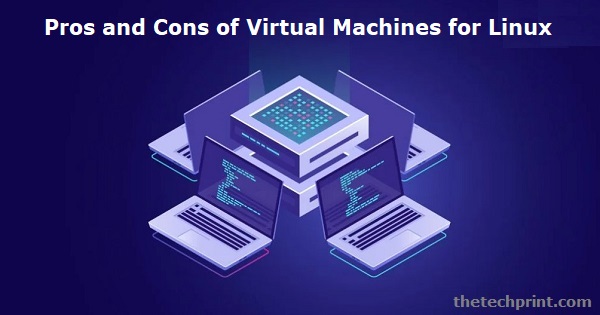Linux Virtual machines run Linux distribution as a guest operating system. As the OS is undergoing frequent updates, you can experiment with Hypervisor (Kernel-based VM). Linux virtual machines (VMs) are increasingly popular, especially in the cloud. There are many reasons for this popularity, but the chief among them is that VMs offer a high degree of flexibility and portability. But with every type of technology, there are certain limitations. Let's look at the Pros and Cons of virtual machines for Linux and find out more.
A VM is essentially a software emulation of a physical computer. This means you can run multiple VMs on a single physical machine, each with its own operating system (OS) and applications. This is possible because the hypervisor (the software that manages the VMs) abstracts away the underlying hardware, making it appear that each VM has its own dedicated hardware resources. Here are some associated pros of virtual machines for Linux OS.
A virtual machine can help you save on hardware costs. If you need to test an application or run a second operating system, you can do so on a single computer by creating a virtual machine.
You can better use your computing resources by running multiple virtual machines on a single physical machine. For example, if you have four servers with underutilized resources, you can consolidate those servers into two or even one physical server and run multiple VMs.
In some cases, it may not be possible to install an operating system or application directly on your computer’s hardware. However, by using a virtual machine, you can create an environment compatible with the software you need to run.
With a virtual machine, you can easily change the configuration of your computer to meet your changing needs. For example, you can add a virtual disk to your VM if you need more storage space. Or, if you need to change the operating system, you can create a new VM with the OS you want and delete the old one.
You can increase security by isolating your applications and data in a virtual machine. If an attacker were to gain access to your physical machine, they would not be able to access your VMs without additional exploits. Additionally, you can take advantage of Linux VM like snapshotting and cloning to create backups of your VMs that can be used to recover from an attack quickly.
Speaking of the pitfalls, there’s not much difference between the Cons of Virtual Machine for Linux and other operating systems. Here is a look at them.
A virtual machine will generally not be as fast as a physical machine. This is because the hypervisor must translate requests from the VM to the underlying hardware, which can introduce latency. Additionally, you are sharing resources with other VMs on the same physical host, which can also impact performance.
Setting up and managing virtual machines can be complex. If you are unfamiliar with virtualization technology, it can take time to learn how to use it effectively. Additionally, if you need to run multiple VMs on a single physical machine, you will need to be sure to allocate enough resources to each VM to avoid resource contention.
Just like every other operating system, you may need to purchase additional licenses for the software you want to run on your virtual machine. For example, if you want to run Windows in a VM, you must purchase a separate license for that Windows installation. Additionally, if you run multiple VMs on a single physical machine, you may need to purchase additional licenses for the hypervisor and management software.
Hardware limitations of virtual machines for Linux may trouble you further. Not all hardware is supported in a virtual machine. For example, you may not use certain types of devices, such as GPUs or high-end networking cards, in a VM. Additionally, the performance of some devices may be reduced when used in a VM.
Although virtualization can increase security by isolating your applications and data, it can also introduce new security risks. For example, if you do not properly configure your VM settings, an attacker could gain access to your host machine through your VM. Additionally, if you are running multiple VMs on a single physical machine, an attacker that gains access to one VM could gain access to other VMs on that same machine.
Conclusion on the pros and cons of Virtual Machine for Linux
Linux virtual machines have advantages and disadvantages that you should consider when deciding whether or not to use them. The benefits of increased security, flexibility, and compatibility may sometimes outweigh the performance impact. However, a physical machine may be a better option if you need the highest possible performance or are unfamiliar with virtualization technology. Whether or not to use a VM will depend on your specific needs and requirements.

The most popular Linux virtualization software includes KVM, Xen, and VMware.
The disadvantages of using a virtual machine include reduced performance and increased complexity. Additionally, VMs can introduce new security risks if they are not properly configured. Finally, not all hardware is supported in a VM environment.
One of the limitations of Linux VM is that it may not be able to use certain types of devices, such as GPUs or high-end networking cards, in a VM. Additionally, the performance of some devices may be reduced when used in a VM. Finally, VMs can introduce new security risks if not properly configured.
Whether or not to use a Linux VM will depend on your specific needs and requirements. In some cases, increased security, flexibility, and compatibility benefits may outweigh the performance impact. However, a physical machine may be a better option if you need the highest possible performance or are unfamiliar with virtualization technology.